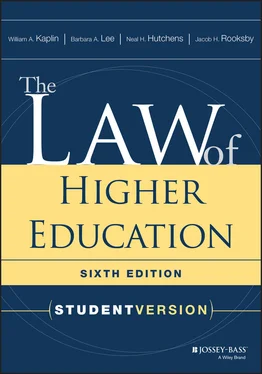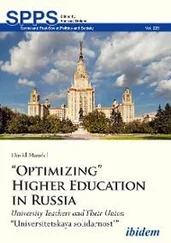The student had the burden of proving the existence of a legal duty by identifying specific interests that arose from his relationship with the college. Concentrating on the college's regulation prohibiting the possession or consumption of alcoholic beverages on campus or at off-campus college-sponsored functions, he argued that this regulation created a custodial relationship between the college and its students. A basic principle of law holds that one who voluntarily takes custody of another is under a duty to protect that person. The plaintiff reasoned that he was entitled to the protection voluntarily assumed by the college when it promulgated the regulation. The court dismissed this argument on the ground that the college regulation merely tracked state law, which prohibited persons under the age of 21 from drinking intoxicants. By promulgating the regulation, then, the college did not voluntarily assume a custodial relationship but only reaffirmed the necessity of student compliance with Pennsylvania law.
Bradshaw influenced the rulings of other courts throughout the 1980s, the most frequently cited of which are Beach v. University of Utah , 726 P.2d 413 (Utah 1986), and Rabel v. Illinois Wesleyan University , 514 N.E.2d 552 (Ill. App. Ct. 1987). The student in Beach was injured after falling off a cliff while participating in a university-sponsored field trip. The student, who was under the legal age for drinking alcohol, had consumed alcohol in full view of the faculty advisor shortly before wandering off and falling. Despite the fact that the university had promulgated regulations against drinking, and the faculty member had failed to enforce those regulations, the court refused to impose liability on the university. The student in Rabel was abducted from her residence hall by a fellow student engaged in a fraternity initiation; the court found no duty, even with respect to the university's role as landlord of the residence hall.
This “bystander” approach appears to be falling out of favor with courts, which, in cases decided over the past decade, are now imposing the same duty on colleges and universities that has traditionally been required of business organizations, landlords, and other nonacademic entities. Institutions may be liable for the negligence of their employees and, under certain circumstances, may even be found liable for the negligence of nonemployees. For example, in Foster v. Board of Trustees of Butler County Community College , 771 F. Supp. 1122 (D. Kan. 1991), a basketball coach had asked a student to pick up a potential recruit at the airport and drive him to a nearby motel. On his return from the airport, the student ran a red light and hit a truck, resulting in his death and injuries to the recruit and the truck driver. Both injured parties sued the college.
A jury awarded the injured recruit $2.26 million against the college and the estate of the driver. On appeal, the college argued that it was not responsible for the actions of the student driver. The court, noting that the student's car was uninsured and unregistered and that the student had no valid driver's license, ruled that “the Butler Community College defendants could have discovered [the driver's] unfitness for the task had any investigation been conducted” (771 F. Supp. at 1128). The college had policies requiring students driving on the college's behalf to be licensed; the college's failure to follow its policies and its failure to ascertain whether the student was qualified to undertake the responsibility it assigned him resulted in the court's determination that, for purposes of respondeat superior liability, the student was a “gratuitous employee” of the college.
Despite the outcome in the Butler Community College case, colleges are usually not responsible for the torts of students. For example, in Gehling v. St. George ' s University School of Medicine , 705 F. Supp. 761 (E.D.N.Y. 1989), affirmed without opinion , 891 F.2d 277 (2d Cir. 1989), medical students who treated a colleague after he collapsed in a road race did not expose the medical school to malpractice liability; the court ruled that they had not acted as agents of the school. The outcome might have been different, however, if the medical students had been involved in an athletic event sponsored by the medical school.
An emerging area of potential negligence liability for colleges, and their staffs, is computer security. For example, in addition to potential liability for computer usages that violate federal statutes or the First Amendment, institutions may become liable for negligent loss or disclosure of confidential electronic records, negligent supervision of employees who use electronic information for unlawful purposes, negligent failures to keep networks secure from outsiders who gain access for unlawful purposes, or negligent transmission of data that intrudes upon privacy interests of students, faculty, staff, or outsiders.
3.2.2.2 Premises liability.These claims involve injuries to students or other invitees who allege that a college or university breached its duty as a landlord or landowner to maintain reasonably safe buildings (classrooms, residence halls, sports facilities, performing arts centers) and land (parking lots, athletics field, pathway, sidewalks). If a “dangerous” condition is obvious, there is no duty to warn an invitee of potential danger. For example, in Shimer v. Bowling Green State University , 708 N.E.2d 305 (Ohio Ct. Cl. 1999), a student who fell into an open orchestra pit sued the college for the injuries she sustained. The court found for the college, stating that the plaintiff, who had been working on a theater production and was familiar with the stage and the orchestra pit's location, was negligent in not using care to avoid falling into the pit.
In a more typical premises liability case, on move-in day, a parent of a student at Louisiana Tech University slipped on a mat at the entry to a university dormitory, after a university employee allegedly warned her of the dangers of wearing flip-flops while moving in her son on a rainy day. A state court of appeals held that the lower court's award of summary judgment to the university defendant was not appropriate, as genuine issues of material fact existed as to whether the university should have been aware of the hazard caused by rainwater on the floor near the entry to the dormitory during high-traffic time on a rainy day. Kadlec v. Louisiana Tech. Univ ., 208 So.3d 992 (La. Ct. App. 2016).
Premises liability cases often turn on the defendant's knowledge of the presence of a dangerous condition. For example, in University of Texas v. Bellinghausen , No. 03-14-00749-CV, 2016 WL 462735 (Tex. Ct. App. 2016), a University of Texas at Austin student slipped and fell on a raised crack in the sidewalk, breaking his arm. He alleged that the university was negligent in allowing the sidewalk to become damaged, as well as for failing to ensure that its employees could reduce the damage and warn others about the dangerous condition. The latter arguments were brought because a university employee allegedly saw the student fall earlier in the same area. Dismissing the claim, the Texas Court of Appeals concluded that it would be speculation that the university had actual knowledge about the dangerous condition that would establish a duty to warn. See also Sampson v. University of Texas , 500 S.W.3d 380 (Tex. 2016), in which the Texas Supreme Court determined that a professor's tripping over an extension cord at a tailgate hosted by the law school did not constitute actual knowledge by the university of a dangerous condition or actual knowledge of a potential danger. See also Almarante v. Art Institute of Fort Lauderdale, Inc ., 921 So.2d 703 (Fla. Dist. Ct. App. 2006), where the court ruled that a student injured while crossing a highway that divided the college's campus stated a negligence claim against the college.
Читать дальше












